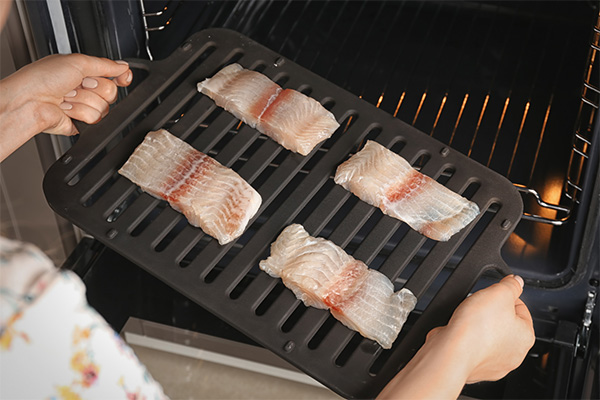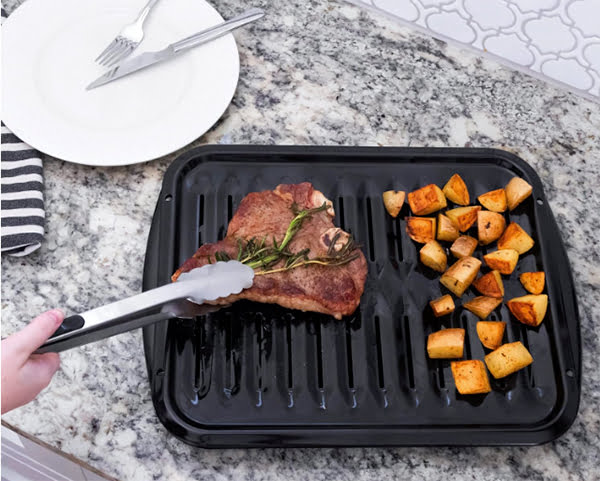Some ways of cooking food are familiar to every cook—boiling, frying, and roasting, for example. However, broiling is much less common! Using a broiler roaster in an oven can be intimidating, particularly because it needs such a high temperature to function properly. Additionally, you will need a special broiler pan to cook food evenly using a broiler.
In this post, we will share what a broiler pan is and how to use it to create perfectly crispy foods.
What Is A Broiler Pan?
Broiler pans (also known as broiler roasting pans) can be made from various materials, such as cast iron, stainless steel, and aluminum. Broiler pans are engineered to endure extremely high temperatures.
Broiler pans have two parts - a main lower pan and a slotted upper pan. Although designs vary from manufacturer to manufacturer, most broiler pans' lower half is shallow. Its purpose is simply to catch any grease or excess fat drippings from the cooking food. The upper pan is perhaps more accurately described as a tray rather than a proper pan. It is what the food rests on while being cooked.
Although both roasting and broiling involve food being surrounded by heat in an oven similarly to roasting food, broiler pans separate the food from any excess fat it produces. Instead of the food being cooked by direct heat from the bottom of the roasting pan, hot air is allowed to circulate around the food more evenly.
What Is The Difference Between A Broiler Pan And A Baking Pan?
A broiler pan and a baking pan are two different types of cookware used for specific cooking methods and purposes. A broiler pan is designed specifically for broiling food.
Typically, a broiler pan comprises two components: a low-profile, flat pan and an upper rack or grate. The food is placed on the rack, allowing excess fats and juices to drain away from the food as it cooks. The shallow pan is designed to catch the drippings and prevent them from creating excessive smoke and flare-ups in the oven. Broiler pan is often used for cooking meats, seafood, and vegetables, and it's a high-temperature cooking method that allows for quick browning and crisping of the food's surface.
On the other hand, a baking pan is a versatile kitchen tool used for baking a wide range of dishes, including cakes, cookies, brownies, casseroles, and more. Baking typically involves cooking at lower, even temperatures for longer periods to allow ingredients to cook through and develop flavors.
Unlike roasting pans, baking pans are usually deeper, rectangular, or square dishes with higher sides. It's designed to hold mixtures and batters while baking, and it may or may not have a lid or cover, depending on the specific type of baking pan.
7 Benefits Of Using A Broiler Pan

Reduced Fat And Grease
Because broiling pans include a lower pan specifically for catching fat drippings, all excess fats from your food will be drained away! Little or no oil is necessary to prevent sticking to the broiling rack, as the food will be placed very close to the heat source, and air will be allowed to circulate around and underneath it.
Increased Texture
Certain textures are achievable when broiling that are difficult to get using other cooking methods! If you are looking for a crispy, crusty, or caramelized exterior, broiling is the cooking process for you. Broiling is particularly well suited to meat dishes. Meat cooked in a broiler pan will achieve a perfect sear while maintaining a soft interior.
Quicker Cook Time
Broiling uses a very hot and dry heat to broil foods. It's the original air fryer! Cooking thick, dense foods can be managed in less than 15 minutes, with proper flipping and turning of the food during broiling.
Efficient Browning
A broiler pan is designed to expose food to direct heat from the top element of the oven or broiler drawer. This direct heat source allows for rapid and even browning of the food's surface, creating a delicious caramelized crust and attractive presentation.
Versatility
Broiler pans can be used for various foods, including steaks, fish fillets, chicken breasts, vegetables, and even sandwiches. It's a versatile tool for achieving that desired sear and crispiness on the top side of your dishes.
Reduced Smoke And Splatter
The shallow pan of the broiler pan is designed to catch the drippings from the food. This reduces the risk of flare-ups and smoke in the oven and makes for easier cleanup afterward.
Easy Cleanup
Several broiler pans are crafted from materials known for their easy-to-clean properties, including stainless steel or non-stick coatings. The design of the pan and rack also makes it simpler to access and clean any food residue or drippings.
3 Downsides Of A Broiler Pan
Specific Purpose
If you don't frequently broil foods, a broiler pan may take up valuable storage space in your kitchen, considering its limited use compared to more versatile cookware.
Not Ideal For Delicate Foods
Broiling is a high-heat cooking method, which may not be suitable for delicate or thin items that can easily overcook or burn. Foods like thin fish fillets or very thinly sliced vegetables may not fare well under the broiler.
Size Constraints
Broiler pans typically come in specific sizes that may not accommodate larger cuts of meat or larger quantities of food. This can be limiting when cooking for a crowd or preparing large meals.
How To Use A Broiler Pan

Find A Broiler Heating Element
If you have never broiled foods before, you may not be aware that your oven has a heating element specifically for broiling! You can typically find it on the top of electric ovens, directly beneath the stovetop burners. Depending on your oven, the oven broiler will look like tubes or strips. Some ovens feature a separate broiling section in a drawer below the oven. Wherever your oven's broiler is located, they will all operate similarly.
Position Oven Racks
Move the oven racks so your broiling pans are closer to the broiler. You need to allow 4 to 5 inches of space between the top of the broiler pan and the broiler oven. Often, this means that the oven rack will need to be moved to the highest position possible. If you are broiling thicker foods, drop the rack down to the second-highest position and allow more space away from the broiler. Broiling food uses high heat to cook food quickly, and thick foods need time for the heat to cook in the middle without the outside being burnt properly.
Turn On Broiler
Broilers require time to preheat, just like the main heating elements in an oven do. Most ovens have a simple on/off switch to control the broiler. If yours does not, set the broiler temperature to 500 degrees Fahrenheit. Because broilers require such a high heat, leaving the oven door slightly ajar while the broiler unit is preheating is standard. This keeps your oven from overheating and triggering a safety feature that would automatically switch it off.
Cook Food On A Broiler Pan
Place your food on the broiler pan and slide the loaded broiler pan into the oven, whether under the broiler or in the broiler drawer. Remember that your food will be placed close to a high-heat source and will not rest in its own juices! It will cook quickly. Watch your food, and be prepared to turn it frequently. Leave the oven door cracked open slightly.
Clean The Broiler Pan
Cleaning a broiler pan can be a bit more involved than cleaning some other cookware due to the potential for burnt-on residues and drippings. Here are the step-by-step instructions to clean a broiler pan:
Step 1: Cool Down the Pan
To make cleaning easier, it's best to clean the broiler pan immediately after use after it has cooled down completely. Attempting to clean it while it's still hot can be dangerous and less effective.
Step 2: Scrape Off Loose Debris
Use a spatula or a spoon to gently scrape off any loose food particles or debris from the broiler pan. Be careful not to scratch the pan's surface if it's non-stick.
Step 3: Soak in Soapy Water
Fill your kitchen sink or a large basin with hot, soapy water. Soak the broiler pan and rack in the water for 15-30 minutes. The warm, soapy water will help loosen the burnt-on residues.
Step 4: Scrub with a Nylon Pad
After soaking, use a nylon scrubbing pad or brush to scrub the pan and rack. Start with gentle pressure and increase as needed to remove stubborn stains. Be careful not to use abrasive materials like steel wool, which can damage non-stick surfaces.
Step 5: Use Baking Soda or Vinegar (if necessary)
You have some options to tackle, especially stubborn or heavily burnt-on residues. One is to create a paste by blending baking soda with a small amount of water and spreading it onto the problem areas. Let it sit for a few minutes before resuming scrubbing. Alternatively, you can heat white vinegar in the microwave, pour it over the affected spots, let it sit for a few minutes, and then proceed with scrubbing.
Step 6: Rinse Thoroughly
Rinse the broiler pan and rack thoroughly with hot water to remove any soap residue, baking soda, or vinegar. Use a clean towel or allow the pan and rack to air dry completely before storing them. Ensure that all moisture is thoroughly removed to prevent rust.
Tips For Using A Broiler Pan
Apply Sauces At The End
If you are using your broiler pan to cook foods that require sugary sauces, such as barbeque sauce and ketchup, keep in mind that the sugar in these condiments will caramelize in a matter of seconds. To avoid burnt food, cook it on the broiler pan without sauce, then brush it on at the very last minute—literally, the last 60 seconds.
Use Aluminum Foil
Non-stick coatings are not suited to extremely high temperatures, so broiler pans are not non-stick. They can be tricky to clean! The easiest way to combat this is by lining your oven-broiling pan with aluminum foil, which can be easily thrown away after cooking. However, remember that you will need to cut slits through the foil of cooking foods that contain natural fat!
Broiler Pan Substitutes
If you'd like to try your hand at broiling but don't have a broiling pan, you can try a few substitutes! You have various options, including baking pans, aluminum foil trays, grill pans, and cast iron pans. All of these options will produce a different result than using a proper broiler pan, but they will get the job done.
